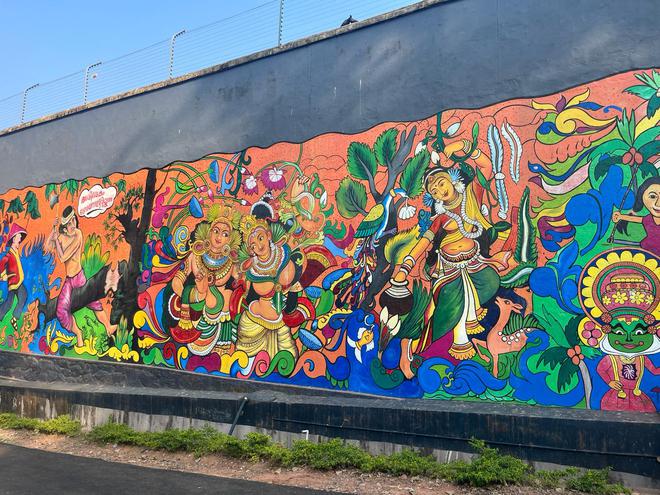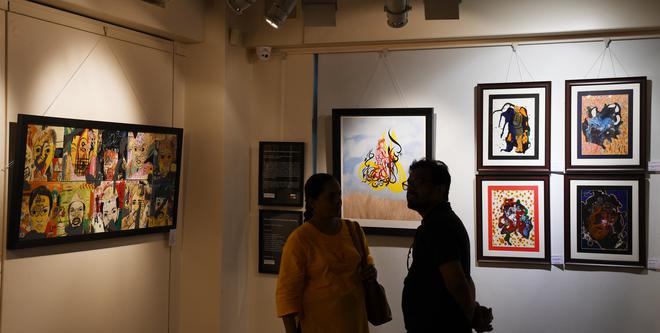At Bikaner Central Jail, inmate Amar has formed a strong bond with three others. “We are sailing the same boat, and the journey becomes easier when you have friends. We drink tea together and exchange our thoughts during tea time,” he says. So, when he joined Jaipur Rugs’ Freedom Manchaha project to learn how to weave and hand-knot carpets, he created a piece with stripes to depict the ups and downs of his life, and four tea cups, to symbolise his friendship. ‘Hum Chaar’, his wool and silk rug, is available on the luxury carpet brand’s website for ₹1,32,300.
Since the project launched in 2018 — across prisons in Alwar, Jaipur, Bikaner, Dausa, Amer and Bharatpur — Jaipur Rugs’ director Yogesh Chaudhary says he’s seen a change. “Many prisoners say it has brought them peace; that weaving is like meditation. It has also helped then regain some of the hope that they had lost.”
Each rug takes between one and three months, and 75% of the sales goes to the prisoners’ families. “Reintegration into society is tough; some commit suicide once they leave jail,” Chaudhary says. “But this profession requires one to stay at home and work, thus making reintegration easier.”
Rajasthan leading the way?
Jaipur Rugs is not the only ones in the State helping motivate prisoners. Over the years, artists, fashion designers, master craftspeople, and even professors from the National Institute of Design have stepped up. This, along with initiatives such as open prisons (Rajasthan has the highest number, at 40), could be one of the reasons why former chief minister Ashok Gehlot stated back in 2021 that the State’s jail system is better than others in India.
“All nine central jails in the State have factories, where training and employment are being given to approximately 2,000 convicts at any given time,” says a spokesperson at the Rajasthan Prison Department. The detainees in Jodhpur and Udaipur, for instance, are proficient in making sheet-metal products; at the Jaipur Central Jail, inmates create pretty quilts, including the famous Jaipuri razai. “Goods worth ₹1.75 crore were produced in these factories last year.”
Aashayein: The Jail Shop at the Jaipur Central Jail is a popular stop for tourists and locals. Selling paintings and handicrafts created by prisoners, the five-year-old store also stocks dhurries, ready-to-wear clothes such as shirts and skirts, wooden furniture, bed covers, and candles. The Police Department is a regular customer, as are several other State departments. The revenue generated is contributed to the Prisoners’ Welfare Fund to purchase raw materials for the inmates.
Talent hunt
While not all states provide creative work outlets for its prisoners, the few that do try to ensure broad-based training. In Kerala, at the Central Prison and Correctional Home in Thiruvananthapuram, a large 200-metre mural on the perimeter wall is a testament to the skills of its inmates. They launched their Classical and Commercial Arts vocational training course three years ago, in association with the State Resource Centre. “We extend training to 20 persons in a batch at a time,” says D. Sathyaraj, superintendent of the prison. “Rather than run the course over a few months, it is more intense and wraps up in 70 hours — keeping in mind the floating nature of the prison population.”

The focus is on mural and canvas paintings, nettipattam (caparisons donned by elephants during temple festivals), and wooden decorative items. While Sathyaraj feels that the arts and crafts production is yet to hit mass commercial volumes, the response has been good for the products sold through Free Fashionista, their on-site store. “A share of the sales is set aside for the prisoners,” he says. “Inmates who are interested can sign up. We also identify those that have the talent.”
In Telangana, at Chanchalguda Jail, authorities have started teaching kalamkari to its women inmates. “We launched the programme last month, after noticing the demand for the textile,” says superintendent Shiva Kumar. Carpentry is also taught at Chanchalguda and Cherpally. “The products made by prisoners, including dhurries, woollen garments, and yoga mats, are also sold at the 38 prison-run petrol stations across the State and through our ‘My Nation’ stalls at fairs.”
Canvases not barred

Reformation models
Creativity in prisons isn’t always channelled into workshops, though. At Tihar Jail, after organising art and craft classes, Project Second Chance is now concentrating on creating reformation and rehabilitation models to help prisoners. “There aren’t enough innovative models in India. And who better to create them than the ones who have lived through these problems,” says Mohit Raj, the founder of the initiative. These include Better-Life Prison School; Kunji, a helpline for ex-inmates; and using games like Jenga and Ludo to help teach legalese and conflict resolution in mental health.
But that’s not to say the creative initiatives are in the past. “Soon, in Jail No. 6, we will be starting pottery classes,” he says. Raj recalls one of their bigger creative projects, a painting workshop led by artist Veer Munshi in 2017. Prisoners made 300 paintings, with which they organised an exhibition-cum-sale at Lalit Kala Akademi. “I own a painting created by Vinay Sharma, who was sentenced in the Nirbhaya case.” Perhaps pottery will be their next outing at the Akademi.
With inputs from Mohammed Iqbal, Praveen M.P. and Naveen Kumar







